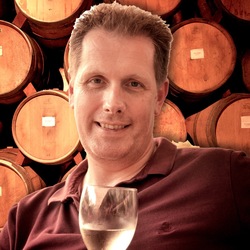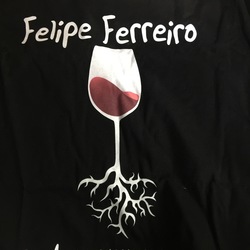Micro Bio Wines
Meyer Family Vineyards
Micro Cuvée McLean Creek Vineyard Pinot Noir 2015


Château Brane-Cantenac
Grand Cru Classé en 1855 Margaux Red Bordeaux Blend 2005
I have a six-pack of this 05. I thought after 10 years in bottle, it would be interesting to check in on its evolution. While tasty, I’ll wait another 8-10 to open another. Even after 2-3 hours in the decanter, it’s still a very young adolescent. On the nose, slightly sour blackberries & dark cherries, dark currants, baked black plum, haunting blue fruits, anise, whiff of spice, steeped tea, dry stones, dry crushed rocks with dry top soil, caramel, vanilla with fresh & dry red florals. The body is thick & full. Tannins are starting to round out. It’s velvety on the palate. The fruits are; bright, fresh & ripe and really show the greatness of the 05 vintage. Dark currants, blackberries, dark cherries, baked black plum, haunting blue fruits, baked strawberries, cherries, raspberries on the long set, dark spice, clay & loamy dry top soil with crushed rocks, dry stones, cigar with ash, graphite, dry stems, slight herbaceous character, mint, used leather, clove, caramel, vanilla, fresh & dry red florals with violets. The round acidity is about perfect. The structure and length are still strong. The balance is in harmony. As for the long finish, it’s lush, ruby, rich and well polished. Photos of; Chateau Brane Cantenac, large wood vats, Henri Lurton and Estate vines. Producer notes and history...Chateau Brane Cantenac began in the early 17th century. At the time, the estate was known as Domaine Guilhem Hosten. Even that far back, wine was produced from the property. In fact, the wine was so highly regarded it was one of the more expensive wines in Bordeaux. It sold for almost as much money as Brane Mouton. This is interesting because of who went on to buy the vineyard in the 1800’s. The Baron of Brane, also known as “Napoleon of the Vineyards”, purchased the Chateau in 1833. At the time of the sale, the estate was called Chateau Gorce-Guy. To get the funds needed to purchase the Margaux vineyard, the Baron sold what is now called Mouton Rothschild, which was at the time of the sale, known as Chateau Brane-Mouton. Not such a good move with hundreds of years in hindsight! In 1838, the Baron renamed property taking his name and the name of the sector where the vineyards were located and called it Chateau Brane Cantenac. The Chateau later passed to the Roy family, who were well-known in the Margaux appellation in those days, as they owned Chateau d’issan. Moving ahead to 1920, the Societe des Grands Crus de France, a group of merchants and growers that owned several chateaux located in the Medoc including; Chateau Margaux, Chateau Giscours, and Chateau Lagrange in St. Julien, purchased Chateau Brane Cantenac. Five years later, M. Recapet and his son-in-law, François Lurton, took over Brane Cantenac along with Chateau Margaux. Lucien Lurton (the son of François Lurton) inherited Brane Cantenac in 1956. Today, the estate is still in the hands of the Lurton family. Brane Cantenac is owned and run by Henri Lurton. After being given the responsibility of managing Brane Cantenac, it was under the direction of Henri Lurton that large portions of the vineyard were replanted. Vine densities were increased, the drainage systems were improved and the plantings were also, slowly changed. The vineyard of Brane Cantenac is planted to 55% Cabernet Sauvignon, 40% Merlot, 4.5% Cabernet Franc and .5% Carmenere. Carmenere was used for the first time in the 2011 vintage. The only other Chateau I know that still uses Carmenere is Clerc Milon. The 75 hectare Left Bank vineyard of Brane Cantenac is essentially unchanged since it earned Second Growth status in the 1855 Classification. At least that is the case with the 45 hectares used to produce the Grand Vin of Brane Cantenac. Those 45 hectares are planted surrounding the Chateau. Those vines are located just in front of the Cantenac plateau and are the best terroir that Brane Cantenac owns. They have other parcels, which are further inland and much of those grapes are placed into their second wine, Le Baron de Brane. Those additional hectares can be divided into 3 main sections. Behind the Chateau, they have 15 hectares of vines on gravel and sand, 10 hectares across the road with sand, gravel and iron and a 13 hectare parcel with gravel called Notton, which is used for their second wine. The vineyard is planted to a vine density that ranges from 6,666 vines per hectare on the plateau and up to 8,000 vines per hectare for the vines located behind chateau, in their sandier soils. The higher levels of vine density are always found in the newer plantings. The terroir of Brane Cantenac consists of deep gravel, sand and clay soil. Experiments in the vineyards are currently looking at becoming more organic in their vineyard management. Today, more than 25% of Brane Cantenac is farmed using organic farming techniques. It is expected that over time, the amount of hectares farmed with organic methods will be increased. Brane Cantenac has gone through 2 relatively recent modernization’s in 1999, when they added began adding the first of their smaller vats to allow for parcel by parcel vinification and then again in 2015 when they completed a much more complete renovation of their cellars and vat rooms. While Brane Cantenac is a traditional producer, they are no stranger to technology as they were one of the first estates to embrace optical grape sorting machines. In very wet vintages, they can also use reverse osmosis. To produce the wine of Chateau Brane Cantenac, the wine is vinified in a combination of temperature controlled, traditional, 22 oak vats, 18 concrete tanks and 20 stainless steel vats that vary in size from 40 hectoliters all the way up to 200 hectoliters, which allows for parcel by parcel vinification. 40% of the fermentation takes place in the oak vats. The oldest vines are vinified in vats that are selected to allow for separate parcel by parcel vinification. The younger vines are vinified more often together in the same vats. However, the Carmenere is entirely micro-vinified, meaning that those grapes were completely vinified in barrel, using micro-vinification techniques. This can also happen because the amount of grapes produced is so small. Some vats can be co-inoculated, meaning they go through alcoholic fermentation and malolactic fermentation simultaneously. At Chateau Brane Cantenac, malolactic fermentation takes place in a combination of French oak tanks and barrels. The wine of Brane Cantenac is aged in an average of 60% new, French oak barrels for 18 months before bottling. The initial 2 months of aging is done with the wine on its lees, which adds more depth to the wine. There second wine is Le Baron de Brane. Le Baron de Brane is not new. In fact, previously, the second wine went under the name of Chateau Notton, which took its name from one of the main parcels where the grapes were planted. During the late 1950’s and into the 1960’s, having a second wine was important as the estate declassified 3 vintages, due to extremely poor, weather conditions in 1956, 1960 and 1963. Production of Chateau Brane Cantenac is about 11,000 cases per year. — 8 years ago

Guy, Annick et Yann Bertrand
Bio Dynamite Morgon Gamay 2014
Mjukt friskt & rent. fina bär, inga tanniner, ingen redux, gott. — 10 years ago
Cantillon Brewery
Grand Cru Bruocsella Bio Lambic 2010
Slightly flat but still so so good — 10 years ago
Micro-Bio Wines
Isse 2 Vignerons Verdejo
Oro, presencia de carbónico, en nariz potente, manzana asada, compota. En boca entrada potente, buen paso y peso, final largo y rico, acidez muy en el final...😜😜😜 — 10 years ago

Hijos de Rivera
1906 Red Vintage La Colorada Strong Pale Lager/Imperial Pils
Honey-like golden color with endless micro bubbles. Sweet barley aromas with hints of honey. Full body beer, very creamy and very smooth flavor profile. Incredible harmonious and smooth passage. I could drink this beer by the gallon, it is so smooth and creamy. 91 pts. — 11 years ago
Domaine Devens
Micro-Cuvée d'Exception Altesse 2011
Momofuku supper club — 13 years ago
Le Bio Balthazar
Minervois Syrah Grenache Noir 2014
@Ian Wright try this one — 8 years ago
Krug
Brut Rosé Champagne Blend
NYE =‘s Krug Rosé. I can’t say I completely agree with what the Krug fireplace mantel suggests, but it’s certainly very delicately delicious and will put a guaranteed smile on your face! The mouthfeel is entirely feminine. The micro bubbles are unmistakable Krug and made with great precision. Fruits of; black raspberries, black cherry, cherries, watermelon mid way to the rhine, strawberries & understated citrus notes with pink grapefruit dominating the blend. The fruits are so restrained but are perfectly styled on the leaner side yet so ripe, juicy and delicious. There’s brioche but it comes fresh from the best of Parisian bakeries. Sea spray, minerality that is so soft & delicate, it’s hard to call it minerality. Krug Rosé reveals the very best, smooth, silky, velvety chalkiness that can be found on this planet. Pink roses/florals for days. Perfect acidity and a glorious, long, rich, beautiful finish that doesn’t end. If you enjoy wines that show pure elegance, perfect finesse and haven’t had Krug Rosé, treat yourself to a bottle or a split. The split may leave you wanting more. However, I can’t think of a better wine/way to celebrate the current year and bring in the next. Happy New Year all! May 2018 be peaceful, successful and spent with your family, best friends, prodigious wines and excellent food pairings! — 8 years ago
Berry Hill Vineyard
Cabernet Franc
It's hard to know what perfection in cab Franc taste like… But this is a bold expression of carefully grown, micro-lot produced CF. in Virginia, there is a lot of latitude and this one is volume and equalizer on 10s! What is amazing about this is how it opened up and improved with air… Like a big block before and after nitrous! — 9 years ago
Cooperativa Jesús del Perdón
Mundo de Yuntero Bio Tempranillo Syrah Blend 2012
Spicy and goodvalue — 9 years ago
M. Chapoutier
Collection Bio Côtes du Rhône Red Rhone Blend
Big vanilla and strawberries. Then slight arugula on the finish. Floral notes are present throughout. Good stuff. — 10 years ago
Azienda Agricola COS
Cerasuolo di Vittoria Classico Frappato Nero d'Avola
Nice to find such a drinkable wine - versatile enough to have with meatballs and spaghetti, yet it seems light enough to have with fish. Or just because. Deep cherry nose. Will be a staple in our house. And bio! — 10 years ago
Bio-Weingut H. u. M. Hofer
Grüner Veltliner 2014
Fantastic on a humid hot day! Classic #GruVee — 10 years ago
Domaine de Vens-Le-Haut
Micro-Cuvée d'Exception Seyssel Altesse 2012
Unusual concentration and phenolics. A bit bitter. Yet delicious. — 11 years ago
Funaro
Pinzeri Bio Grillo
Lovely with lunch in Siracusa — 11 years ago
Michel Guignier
Bio Tradition Morgon Gamay
Betony NYC — 11 years ago
Veuve Clicquot Ponsardin
La Grande Dame Brut Champagne Blend 2006

Bio-Weingut H. u. M. Hofer
Niederösterreich Zweigelt
Favorite white... — 8 years ago
Château Falfas
Côtes de Bourg Red Bordeaux Blend
Perfect bio blend with our ravioli. Lighter than we expected. — 9 years ago
Domaine de Vens-Le-Haut
Micro-Cuvée d'Exception Mondeuse Noire
Full bodied, drinks like a Bordeaux. — 9 years ago
Cá de Noci
Le Rose Emilia Frizzante Bianco bio Sparkling Blend
Thanks to Alice Feiring's Wine Society for this rarity. A delight. I'm surprised they use a regular cork instead of a crown cap or champagne cork. Brave. — 9 years ago
Bio Vio
Marenè Pigato di Albenga 2014
Nice fresh wine that will go great with fish dishes. — 10 years ago
Azienda Agricola Corvezzo
Terre di Marca Frizzante Bio Prosecco
This is probably the best #prosecco I've had in a long time - it's unfiltered (cloudy), organic, and pear-blossom brilliant — 10 years ago
Bio-Weingut H. u. M. Hofer
Zweigelt Rosé 2014
Yummy. Easy drinking. Nice fruit balanced with minerality and acidity. Richer mouthfeel for a rose. — 10 years ago
Cantine Barbera
Micro Cosmo Sicilia IGT Rosso
2011. Two hour decant. Still tight pomegranate in the grill. A nice thing on the side for sure. — 11 years ago
Bio Vio
Bon in Da Bon Pigato di Albenga
Buono come sempre, ma aspetterò ancora a stappare la prossima — 11 years ago
















Neil Vill
Very nice Pinot from British Columbia; delicious with the salmon at Hawksworth — 7 years ago